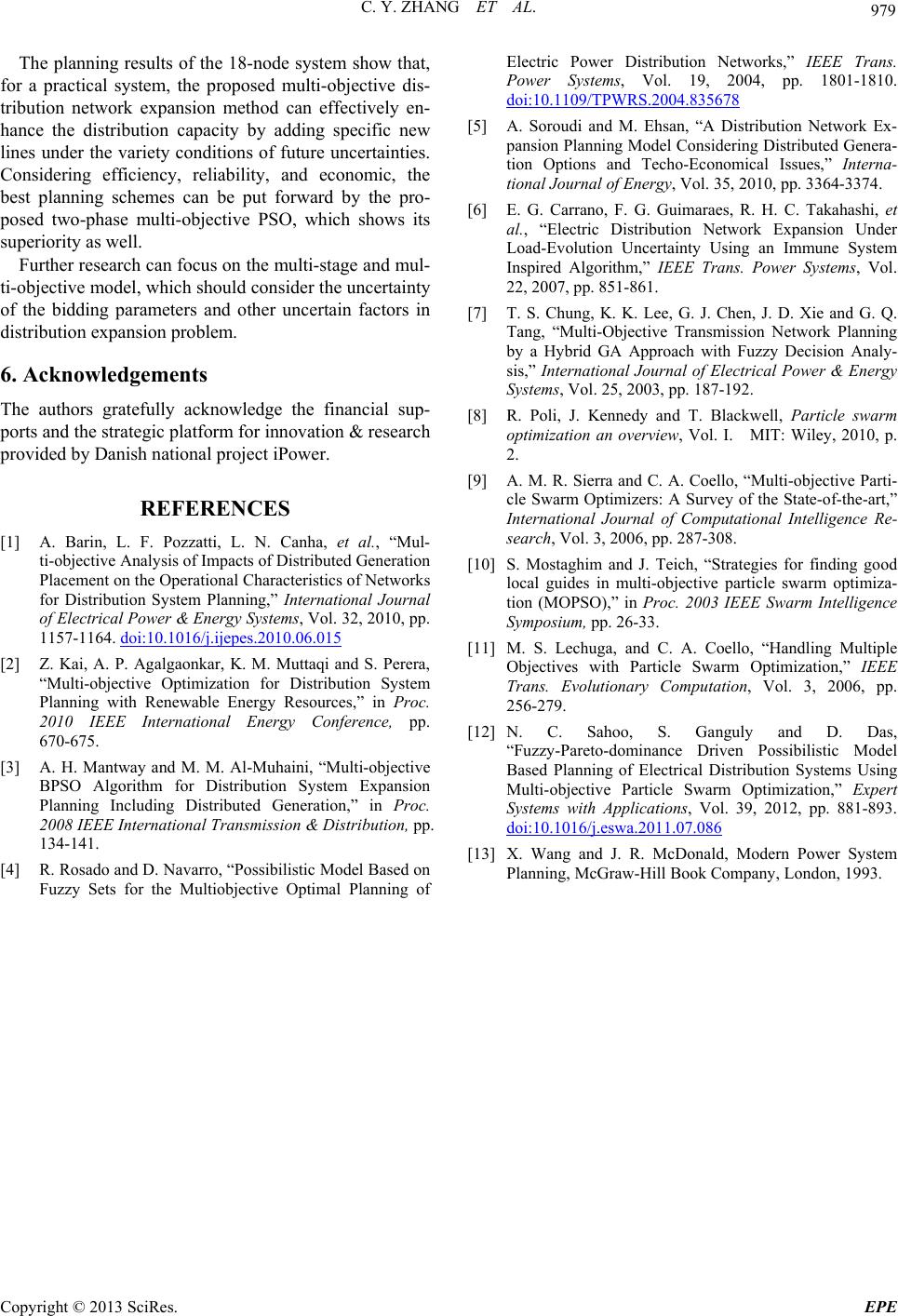
C. Y. ZHANG ET AL. 979
The planning results of the 18-node system show that,
for a practical system, the proposed multi-objective dis-
tribution network expansion method can effectively en-
hance the distribution capacity by adding specific new
lines under the variety conditions of future uncertainties.
Considering efficiency, reliability, and economic, the
best planning schemes can be put forward by the pro-
posed two-phase multi-objective PSO, which shows its
superiority as well.
Further research can focus on the multi-stage and mul-
ti-objective model, which should consider the uncertainty
of the bidding parameters and other uncertain factors in
distribution expansion problem.
6. Acknowledgements
The authors gratefully acknowledge the financial sup-
ports and the strategic platform for innovation & research
provided by Danish national project iPower.
REFERENCES
[1] A. Barin, L. F. Pozzatti, L. N. Canha, et al., “Mul-
ti-objective Analysis of Impacts of Distributed Generation
Placement on the Operational Characteristics of Networks
for Distribution System Planning,” International Journal
of Electrical Power & Energy Systems, Vol. 32, 2010, pp.
1157-1164. doi:10.1016/j.ijepes.2010.06.015
[2] Z. Kai, A. P. Agalgaonkar, K. M. Muttaqi and S. Perera,
“Multi-objective Optimization for Distribution System
Planning with Renewable Energy Resources,” in Proc.
2010 IEEE International Energy Conference, pp.
670-675.
[3] A. H. Mantway and M. M. Al-Muhaini, “Multi-objective
BPSO Algorithm for Distribution System Expansion
Planning Including Distributed Generation,” in Proc.
2008 IEEE International Transmission & Distribution, pp.
134-141.
[4] R. Rosado and D. Navarro, “Possibilistic Model Based on
Fuzzy Sets for the Multiobjective Optimal Planning of
Electric Power Distribution Networks,” IEEE Trans.
Power Systems, Vol. 19, 2004, pp. 1801-1810.
doi:10.1109/TPWRS.2004.835678
[5] A. Soroudi and M. Ehsan, “A Distribution Network Ex-
pansion Planning Model Considering Distributed Genera-
tion Options and Techo-Economical Issues,” Interna-
tional Journal of Energy, Vol. 35, 2010, pp. 3364-3374.
[6] E. G. Carrano, F. G. Guimaraes, R. H. C. Takahashi, et
al., “Electric Distribution Network Expansion Under
Load-Evolution Uncertainty Using an Immune System
Inspired Algorithm,” IEEE Trans. Power Systems, Vol.
22, 2007, pp. 851-861.
[7] T. S. Chung, K. K. Lee, G. J. Chen, J. D. Xie and G. Q.
Tang, “Multi-Objective Transmission Network Planning
by a Hybrid GA Approach with Fuzzy Decision Analy-
sis,” International Journal of Electrical Power & Energy
Systems, Vol. 25, 2003, pp. 187-192.
[8] R. Poli, J. Kennedy and T. Blackwell, Particle swarm
optimization an overview, Vol. I. MIT: Wiley, 2010, p.
2.
[9] A. M. R. Sierra and C. A. Coello, “Multi-objective Parti-
cle Swarm Optimizers: A Survey of the State-of-the-art,”
International Journal of Computational Intelligence Re-
search, Vol. 3, 2006, pp. 287-308.
[10] S. Mostaghim and J. Teich, “Strategies for finding good
local guides in multi-objective particle swarm optimiza-
tion (MOPSO),” in Proc. 2003 IEEE Swarm Intelligence
Symposium, pp. 26-33.
[11] M. S. Lechuga, and C. A. Coello, “Handling Multiple
Objectives with Particle Swarm Optimization,” IEEE
Trans. Evolutionary Computation, Vol. 3, 2006, pp.
256-279.
[12] N. C. Sahoo, S. Ganguly and D. Das,
“Fuzzy-Pareto-dominance Driven Possibilistic Model
Based Planning of Electrical Distribution Systems Using
Multi-objective Particle Swarm Optimization,” Expert
Systems with Applications, Vol. 39, 2012, pp. 881-893.
doi:10.1016/j.eswa.2011.07.086
[13] X. Wang and J. R. McDonald, Modern Power System
Planning, McGraw-Hill Book Company, London, 1993.
Copyright © 2013 SciRes. EPE